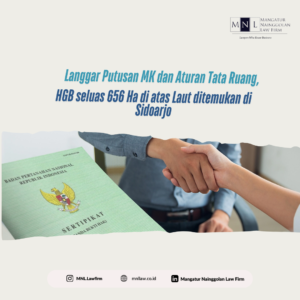
The unresolved case of the sea barrier in Tangerang has been followed by a similar issue in another location, namely in Segoro Tambak Village, Sedati District, Sidoarjo Regency. On Sunday, January 19, through the X account (@thanthowy), Thanthowy Syamsuddin revealed the existence of three parcels of Hak Guna Bangunan (HGB) covering an area of 656 hectares on the sea.
The Head of the Land Office in Sidoarjo Regency, Muh. Rizal responded that these HGBs are still under investigation. Rizal mentioned the possibility that the area was previously reclaimed land or land affected by abrasion, given that the certificates were issued in 1996. However, this claim was easily refuted by Thanthowy through an examination of Google Earth from 1984 to 2022, which showed that the area was consistently a water body.

Illustration: HGB Map via Bhumi ATR BPN Application
Violation of Constitutional Court Ruling and Spatial Planning Regulations
HGB is generally granted over land, not over the sea. This is in accordance with Article 35(1) of the Basic Agrarian Law (UUPA), which states that HGB is a right to establish and own buildings on land that is not owned by the holder.
Government Regulation No. 18/2021 and Minister of Agrarian and Spatial Planning Regulation No. 18/2021 emphasize that HGB can only be issued in land areas. This means that HGB cannot be issued for marine areas unless reclamation has been conducted, and even then, HGB can only be granted after the reclamation process is completed.
Referring to the East Java Spatial Planning Plan (RTRW) 2023 (Regional Regulation No. 10/2023), there is no information indicating that Sedati, Sidoarjo, is a reclamation zone. Instead, the area is designated as a fishing zone, a defense and security zone, and part of the development of Juanda Airport.
The Sidoarjo Spatial Planning Plan 2019 (Regional Regulation No. 4/2019) also asserts that the coastal and marine areas of Sedati are designated as mangrove conservation and fisheries zones.
The Constitutional Court, through its Decision No. 3/PUU-VIII/2010, has annulled the provisions regarding Coastal Water Management Rights (HP-3) regulated under Law No. 27 of 2007 concerning the Management of Coastal Areas and Small Islands. This decision reinforces the principle that marine spaces are common property.
The Court annulled Article 1 point 21, Articles 16, 18, 19, 20, 21, 22, 23, 60, and 61 of Law No. 27 of 2007. These articles governed HP-3, which granted certain parties the right to control and utilize coastal waters. The Court argued that marine spaces are common property and cannot be owned or controlled by individuals or specific groups. The granting of HP-3 was deemed contrary to the principles of social justice and the rights of indigenous communities and traditional fishermen who depend on marine resources for their livelihoods. The Court emphasized that seas and coastal waters are public assets that must be protected and managed for the common good, not for commercial or private interests.
Interpretation of the Annulled Provisions by the Constitutional Court:
- Seas as Common Property: The Court interpreted that seas and coastal waters are public spaces that must not be controlled by specific parties through the HP-3 mechanism. This aligns with the principles of public interest and social justice.
- Protection of Indigenous Communities and Fishermen: The Court stressed the importance of safeguarding the rights of indigenous communities and traditional fishermen who rely on marine resources for their livelihoods. The granting of HP-3 was seen as potentially marginalizing these communities.
- Prohibition of Commercialization of Seas: The Court affirmed that seas must not be commercialized or exploited exclusively by specific parties, as this could damage marine ecosystems and threaten the sustainability of natural resources.
Implications of the Court’s Decision:
- Abolishment of HP-3: Following the Court’s decision, Coastal Water Management Rights (HP-3) can no longer be issued. This means that no exclusive rights can be granted to specific parties to control coastal waters.
- Strengthening Marine Protection: The decision reinforces the principle that seas are common property and must be managed for public benefit, including environmental protection and the empowerment of coastal communities.
- Impact on the HGB Case in Sidoarjo: The discovery of Building Use Rights (HGB) over marine areas in Sidoarjo clearly violates this Court decision, as seas must not be controlled or exploited exclusively through mechanisms like HGB or HP-3.
The discovery of HGB certificates in Sidoarjo constitutes a legal violation. Collaboration among various parties is necessary to enforce the law, investigate the issuance process of the HGB certificates, and work toward their revocation. The government, through the Minister of Agrarian Affairs and Spatial Planning/National Land Agency (ATR/BPN), Nusron Wahid, has stated that the issue will be resolved through two alternative approaches:
- Letting the HGB expire this year and not renewing it.
- Revoking the HGB outright by categorizing it as land destroyed by abrasion.
The issue of HGB and land ownership certificates (SHM) in coastal waters has gained attention since the discovery of the sea barrier in Tangerang. The Bhumi ATR BPN application has also facilitated public access to check registered HGBs in coastal areas. In addition to the cases in Tangerang and Sidoarjo, HGB and SHM certificates have also been found in other coastal areas, such as Sumenep (20 ha) and Makassar (23 ha).
Beyond legal certainty through legislation, law enforcement must continue to be pursued. This issue underscores the importance of addressing marine spatial problems that affect fishermen and indigenous coastal communities. Ownership of HGB and SHM in coastal waters can have detrimental environmental impacts, such as the exploitation of coastal resources from the sea surface to the seabed and commercialization that undermines economic democracy, ultimately marginalizing traditional fishing communities.
